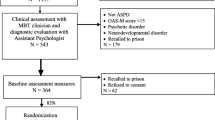Abstract
The population of prison inmates in the United States is rapidly growing; in 1994 it was estimated that 1.7 million Americans were incarcerated. Changes in the complexion of the prison population highlight the need for successful mental health interventions for special populations. Specifically, increasing numbers of women, middle aged inmates, physically ill inmates, and inmates with severe mental illness have challenged an already taxed system. Many inmates have complex pathology in which substance abuse, psychosis, affective disorders, personality disorders and medical illnesses play overlapping roles. One of the most challenging aspects of care involves management of inmates who are aggressive to themselves or others. This article discusses the approach to managing inmates with aggressive behavior and complex mental health issues. Specific diagnoses are discussed as are the general approaches best used to assess new onset violent behavior in a mentally ill prison inmate.
Similar content being viewed by others
REFERENCES
Gilliard DK, Beck AJ: Prison and jail inmates, 1995. Bureau of Justice Statistics Bulletin, NCJ-161132. Washington D.C., U.S. Department of Justice, 1996.
Prison and jail inmates at midyear 1997: NCJ 167247, January 1998.
Hammett TM, Daugherty AL: 1990 Update: AIDS in correctional facilities. Washington D.C. United States Department of Justice, 1991.
Fava M, Nierenberg A, Quitken F, et al.: A preliminary study on the efficacy of sertraline and imipramine on anger attacks in atypical depression and dysthymia. Psychopharmacological Bulletin 33:101–103, 1997.
Lebert F, Pasquier F, Petit H: Behavioral effects of trazadone in Alzheimer's Disease. Journal of Psychiatry 55:536–538, 1994.
Mellow A, Solano-Lopez C, Davis S: Sodium valproate in the treatment of behavioral disturbance in dementia. Journal of Geriatric Psychiatry and Neurology 6:205–209, 1993.
Jeanblanc W, Davis Y: Risperidone for treating dementia-associated aggression. American Journal of Psychiatry 152:1239, 1995.
Brooke MM, Patterson DR, Questad KA, et al.: The treatment of agitation during initial hospitalization after traumatic brain injury. Archives of Physical and Medical Rehabilitation 73:917–921, 1992.
Yudofsky S, Silver JM, Schneider S, et al.: Pharmacologic treatment of aggression. Psychiatric Annals 17:397–407, 1987.
Bond W, Mandos L, Kurtz M: Midazolam for aggressivity and violence in three mentally retarded patients. American Journal of Psychiatry 146:925–926, 1989.
Ratey J, Mikkelsen E, Smith G, et al.: Beta blockers in the severly and profoundly mentally retarded. Journal of Clinical Psychiatry 53:41–46, 1992.
Tyrer SP, Walsh A, Edwards DE, et al.: Factors associated with a good response to lithium in aggressive mentally handicapped subjects. Progression in Neuropsychopharmacology and Biological Psychiatry 8:751–755, 1984.
Craft M, Ismail IA, Krishnamurti D, et al.: Lithium in the treatment of aggression in mentally handicapped patients: A double-blind trial. British Journal of Psychiatry 150:685–689, 1987.
Markovitz P: Effects of fluoxetine on self-injurious behavior in the developmentally disabled: A preliminary study. Journal of Clinical Psychopharmacology 12:27–31, 1992.
Ratey, J, Sovner R, Parkes A, et al.: Buspirone treatment of aggression and anxiety in mentally retarded patients: A multiple-beseline, placebo lead-in study. Journal of Clinical Psychiatry 52:159–162, 1991.
Teplin LA: Psychiatric and substance abuse disorders among jail urban detainees. American Journal of Public Health 84:290–293, 1994.
Teplin LA, Alaskam KM, McClelland GM: Prevelance of psychiatric disorders among incarcerated women. Archives of General Psychiatry 53:505–512, 1996.
Reilly P, Clark H, Shopshire M, et al.: Anger Management and temper control: Critical components of posttraumatic stress disorder and substance abuse treatment. Journal of Psychoactive Drugs 26:401–407, 1994.
Davidson J, Roth S, Newman E: Treatment of post-traumatic stress disorder with fluoxetine. Journal of Traumatic Stress 4:419–423, 1990.
van der Kolk B, Dreyfuss D, Michaels M, et al.: Fluoxetine in posttraumatic stress disorder. Journal of Clinical Psychiatry 55:517–522, 1994.
Nagy L, Morgan C, Southwick S, et al.: Open prospective trial of fluoxetine for post traumatic stress disorder. Journal of Clinical Psychopharamacology 13:107–113, 1993.
Forster P, Schoenfeld F, Marmar C, et al.: Lithium for irritability in posttraumatic stress disorder. Journal of Traumatic Stress 8:143–149, 1995.
Author information
Authors and Affiliations
Rights and permissions
About this article
Cite this article
Lewis, C.F. Successfully Treating Aggression in Mentally Ill Prison Inmates. Psychiatr Q 71, 331–343 (2000). https://doi.org/10.1023/A:1004684223522
Issue Date:
DOI: https://doi.org/10.1023/A:1004684223522



